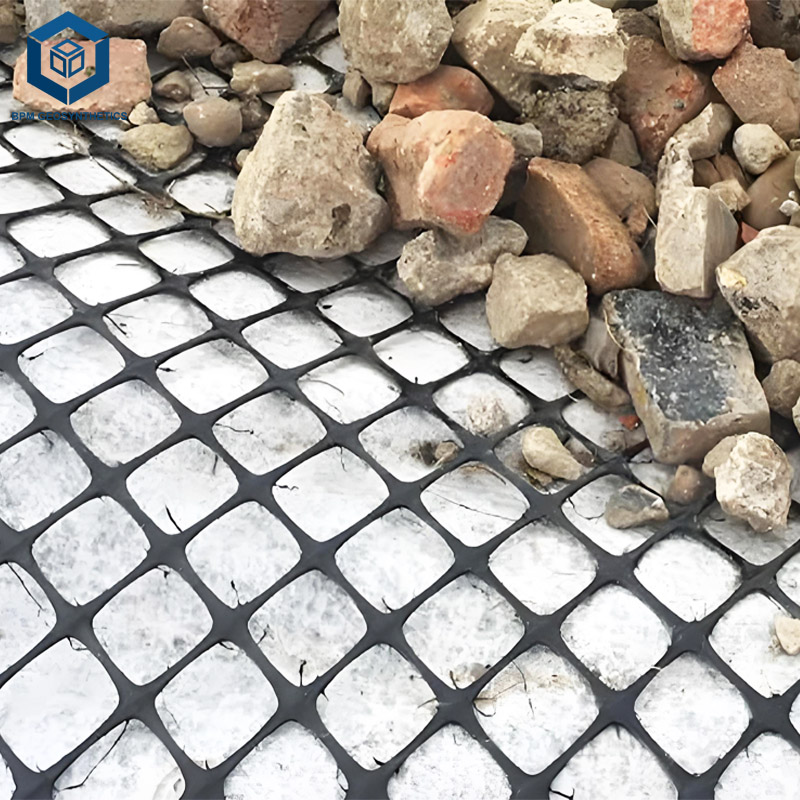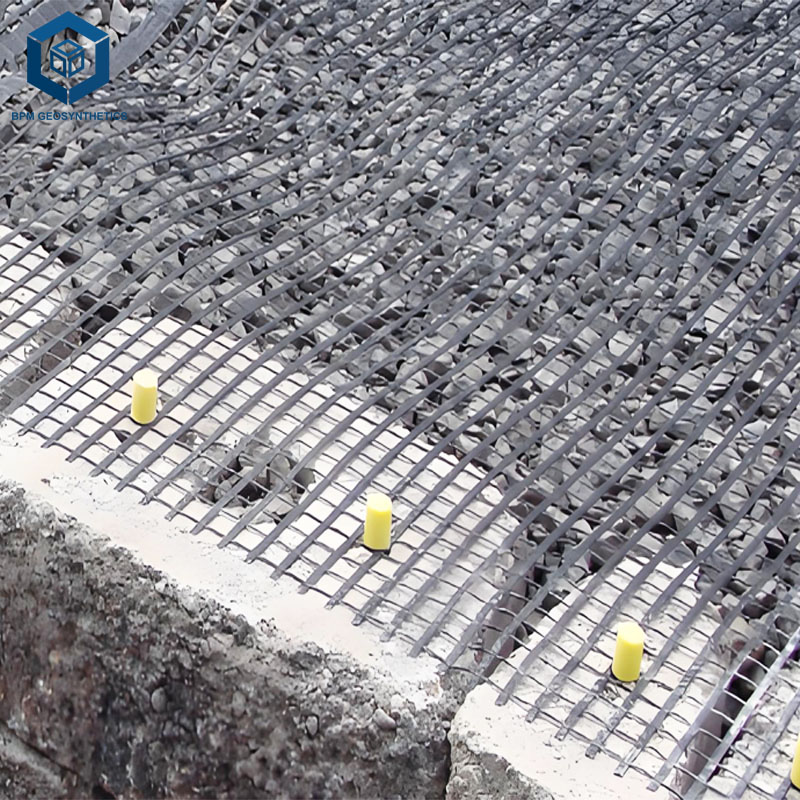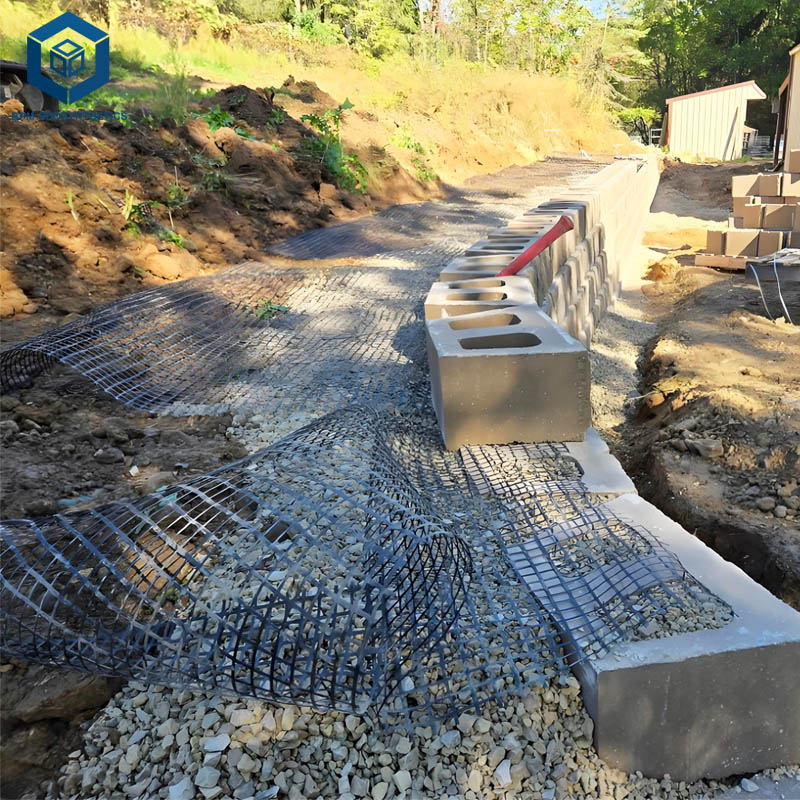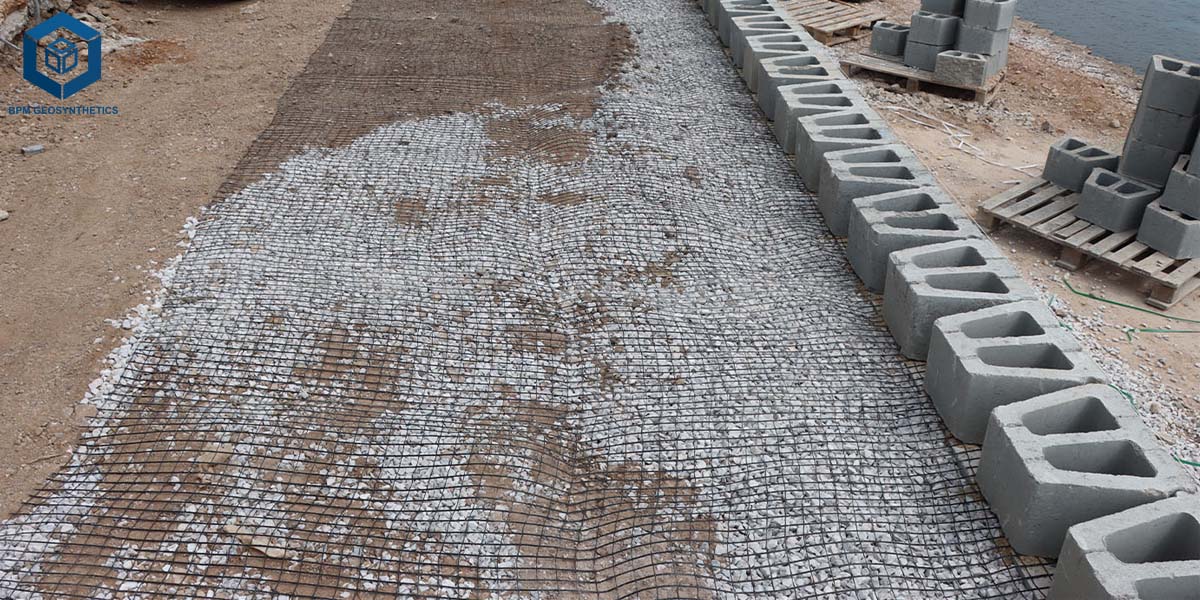Geogrid Wall Construction
Geogrid wall construction uses high-strength polymer grids to reinforce soil structures, providing stability, durability, and long-term performance. It is widely applied in retaining walls, slope protection, embankments, and other geotechnical engineering projects. The geogrid interlocks with soil or aggregate, forming a strong and flexible retaining system that resists deformation and erosion.
Key Features & Specifications:
- Material: HDPE, PP, or PET
- Type: Uniaxial Geogrid
- Tensile Strength: 20–200 kN/m (customizable)
- Aperture Size: 25–100 mm (depending on design)
- Width & Length: 1–6 m rolls, customized lengths available
- Applications: Retaining walls, slopes, roadbeds, embankments, bridge abutments, and erosion control
Geogrid Wall Construction is a contemporary engineering method that makes use of high-strength polymer geogrids to give a boost to and stabilize soil structures. This machine enhances the load-bearing potential and balance of preserving walls, slopes, embankments, and different soil-filled structures. Designed for long-term sturdiness and value efficiency, geogrid wall construction have turn out to be an fundamental phase of geotechnical and civil engineering tasks worldwide.
1. Geogrid Wall Construction Product Overview
Geogrids are open, grid-like artificial substances made from high-molecular polymers such as HDPE (High-Density Polyethylene), PP (Polypropylene), or PET (Polyester). They supply tensile reinforcement via interlocking with the surrounding soil or aggregate, developing a composite shape with choicest mechanical performance.
The geogrid retaining wall approves engineers to assemble vertical or steep maintaining partitions barring the want for big concrete structures, providing a bendy and environmentally pleasant solution.
2. Geogrid Wall Construction Material and Structural Types
2.1 Geogrid Wall Construction Material Options
2.1.1 HDPE Geogrid (High-Density Polyethylene)
HDPE geogrids are manufactured thru an extrusion and stretching method that produces a inflexible and high-strength grid structure.
- Chemical & Environmental Resistance: HDPE geogrid show off exquisite resistance to most acids, alkalis, and natural solvents, making them perfect for use in harsh and contaminated environments. They are additionally resistant to organic degradation, making sure long-term steadiness in aggressive soils.
- Mechanical Strength: With gorgeous tensile power and rigidity, geogrid mesh grant sturdy interlock with soil and mixture materials, decreasing lateral motion and growing load distribution efficiency.
- Durability: The geo grid mesh has low water absorption and excessive UV stability, stopping degradation from moisture and daylight for the duration of extended out of doors exposure.
- Applications: Commonly used in landfills, drainage systems, coastal embankments, and chemical containment areas.
- Advantages: High durability, superb chemical and UV resistance, long carrier life, and minimal protection requirements.
- Installation Notes: Due to their stiffness, biaxial geogrid have to be treated cautiously to hold flat placement; overlapping joints must be right secured to make sure non-stop reinforcement.
2.1.2 PP Geogrid (Polypropylene)
PP geogrid is lightweight and flexible, presenting a realistic stability of cost-effectiveness and dependable overall performance in accepted soil reinforcement projects.
- Mechanical Strength: PP retaining wall with geogrid possess excessive tensile power and average stiffness, imparting ample reinforcement for low to medium load-bearing applications.
- Chemical Stability: Resistant to most chemical substances and microorganisms in soil, making sure overall performance in a range of environments.
- Weight & Handling: Lightweight and handy to install, lowering building time and transportation costs.
- Durability: UV-stabilized in the course of manufacturing for higher resistance to sunlight, although long-term publicity need to nevertheless be minimized.
- Applications: Ideal for slope reinforcement, transient protecting walls, and subgrade stabilization in avenue and railway construction.
- Advantages: Economical, effortless to install, environmentally friendly, and appropriate for short- to medium-term engineering projects.
- Installation Notes: PP geogrid driveway have to be protected with soil quickly after set up to stop UV degradation; desirable tensioning and anchoring are fundamental for most appropriate soil interlock.
2.1.3 PET Geogrid (Polyester)
PET geogrid is made from high-strength polyester fibers, lined with shielding polymers to beautify chemical and UV resistance.
- Mechanical Performance: They provide very excessive tensile electricity and extraordinarily low creep, making them suitable for buildings subjected to regular and long-term loading.
- Dimensional Stability: PET fibers keep regular power even below excessive temperature and humidity conditions, making sure dependable overall performance over decades.
- Chemical Resistance: Coated with PVC or bitumen to withstand alkaline and acidic environments, protecting fibers from chemical attack.
- Applications: Commonly used in protecting wall reinforcement, dual carriageway embankments, railway subgrades, and large-scale slope stabilization projects.
- Advantages: Superior long-term creep resistance, great bonding with soil and aggregates, and excessive tensile modulus for minimal deformation.
- Installation Notes: Avoid mechanical injury to the coating at some point of installation; make sure smooth soil contact for full tensile engagement and overall performance efficiency.
2.2 Geogrid Wall Construction Structural Types
2.2.1 Uniaxial Geogrid
Uniaxial geogrid is designed with ribs and apertures oriented principally in one direction, supplying tremendous tensile energy alongside that axis.
- Load Capacity: Engineered to withstand sturdy tensile masses generated with the aid of soil stress in maintaining partitions and slopes.
- Applications: Extensively used in bolstered soil maintaining walls, bridge abutments, and steep slope reinforcement systems.
- Advantages:
High tensile power in a single route for superb earth retention
Reduces wall deformation and will increase typical stability
Cost-effective in contrast to traditional concrete protecting systems
- Design Notes: Proper orientation of the geo grid ground grid is critical; the high-strength course need to face the soil strain zone. The anchorage size at the back of the wall ought to be cautiously calculated to make certain stability.
- Installation Tips: Install in tension-free situation with easy compaction of backfill layers to reap most soil interlock.
2.2.2 Biaxial Geogrid
Biaxial geogrids are designed to furnish tensile power in each longitudinal and transverse directions, making them appropriate for functions the place masses are allotted in more than one directions.
- Load Distribution: Balanced tensile energy in each instructions correctly disperses loads, stopping contract and rutting in avenue bases.
- Applications: Used in avenue and pavement reinforcement, railway subgrades, airport runways, and platform stabilization.
- Advantages:
Enhances load distribution and prevents deformation
Improves soil bearing ability and reduces renovation costs
Simplifies set up with no want for directional alignment
- Design Notes: The geo grid for gravel geometry permits even distribution of stress, decreasing differential contract and extending pavement life.
- Installation Tips: Ensure geo grid for retaining wall is laid flat with enough overlap (typically 300–500 mm) between adjoining rolls and compact fill cloth proper to make sure full interlock.
2.2.3 Triaxial Geogrid
Triaxial geogrids are an superior structure providing a triangular aperture shape that presents multi-directional electricity and high-quality combination confinement.
- Performance: The special triaxial sample permits stress to be allotted in 360 degrees, enhancing load switch effectivity and typical stability.
- Applications: Ideal for high-performance pavements, heavy-duty roads, industrial yards, and rail music reinforcement.
- Advantages:
Superior mixture interlock and confinement
Significantly reduces lateral spreading of base material
Enhances structural stiffness and extends pavement life
Performs quite nicely below dynamic and repetitive loading
- Design Notes: Provides up to 50% higher load dispersion in contrast to biaxial grids, making it the fine preference for annoying infrastructure.
- Installation Tips: Use angular mixture to make certain sturdy interlock; compact in skinny layers for uniform reinforcement and maximum performance.
3. Geogrid Wall Construction Technical Specifications
Parameter | Range / Option |
Tensile Strength | 20–200 kN/m |
Aperture Size | 25 × 25 mm – 100 × 100 mm |
Roll Width | 1–6 meters |
Roll Length | 50–200 meters (customized available) |
Color | Black / Grey / Customized |
Standard | ASTM / ISO / CE Certified |
4. Geogrid Wall Construction Key Performance Features
4.1 High Tensile Strength
Geogrid wall construction are engineered to supply most beneficial tensile strength, presenting extremely good reinforcement to soil structures. This property approves the geogrid slope stabilization to take in and distribute lateral earth pressures effectively, stopping wall deformation and retaining structural steadiness underneath heavy loads. The interlocking mechanism between soil and uniaxial geogrid improves shear resistance, making sure that the wall or slope retains its designed form even in difficult geotechnical conditions.
4.2 Excellent Chemical Resistance
Geogrid material made from HDPE, PP, or PET polymers show off terrific resistance to a large vary of chemicals, which include acids, alkalis, and natural solvents. This function permits the geogrid fabric for retaining walls to operate reliably in more than a few environments such as contaminated soils, landfill liners, industrial sites, and coastal areas. The excessive chemical balance ensures that the geogrid will now not degrade or lose electricity when uncovered to aggressive agents, making it a reliable answer for long-term soil reinforcement and environmental protection.
4.3 UV Stabilized for Long-Term Exposure
During manufacturing, plastic geogrid is handled with specialised UV stabilizers to face up to harm from extended daylight exposure. This safety ensures that the geogrid mesh retaining wall keeps its structural integrity and performance, even when hooked up in open environments or used briefly earlier than backfilling. The UV stabilization extends the provider lifestyles of the geogrid wall, making it appropriate for use in slopes, protecting walls, and different outside functions the place daylight publicity is inevitable.
4.4 Lightweight and Flexible Design
Despite their excessive strength, geogrid gravel is light-weight and flexible, making them handy to handle, transport, and deploy on-site. This flexibility approves the cloth to conform to uneven floor surfaces barring dropping its reinforcing capability. Installation effectivity is notably improved, lowering labor time and costs. Additionally, the light-weight nature of the rolls simplifies logistics, enabling quicker deployment in large-scale civil and environmental development projects.
4.5 Low Creep and High Durability
One of the key blessings of geogrid materials, in particular PET-based types, is their low creep conduct underneath sustained loading. This ensures the long-term steadiness of protecting walls, slopes, and embankments with the aid of keeping tensile energy and stopping deformation over time. The geogrid ground grid is additionally resistant to organic and environmental degradation, making sure reliable overall performance for countless many years even underneath non-stop stress and publicity to various soil and climate conditions.
4.6 Cost-Efficient Structural Design
Geogrid wall development substantially reduces the want for traditional building substances like concrete and metal reinforcements. By bettering soil energy and stability, it approves engineers to sketch thinner walls, smaller foundations, and decreased excavation requirements. This no longer solely lowers cloth and transportation charges however additionally minimizes environmental impact. The cost-effectiveness of geogrid options makes them a favored desire for present day infrastructure initiatives searching for each monetary and sustainable advantages.
5. Choose BPM Geosynthetics Geogrid Wall Construction
The Best Project Material Co., Ltd.(BPM Geosynthetics)presents extraordinary Geogrid Wall Construction structures manufactured with superior extrusion and stretching technology. Each product is examined beneath strict ASTM and ISO requirements to warranty dependable mechanical overall performance and long-term durability. With custom-made solutions, international delivery, and technical support, BPM Geosynthetics ensures your geotechnical initiatives reap choicest safety, efficiency, and sustainability.











